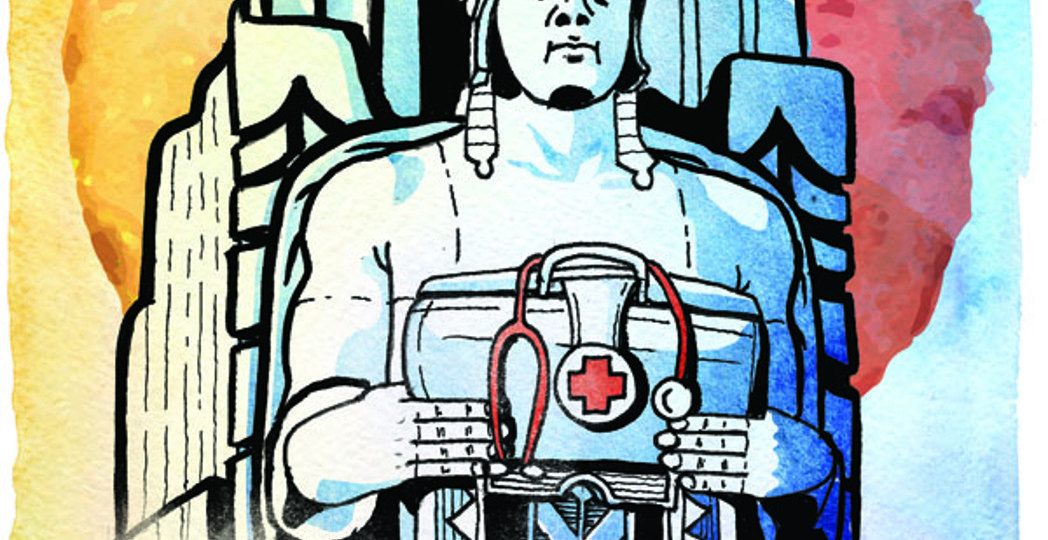White Coats
by Richey Piiparinen | Apr. 15, 2016 | 4:00 AM

Shannon Sullivan
In Cleveland, migration is synonymous with leaving — a slow death to a city.
Marco Costa did just the opposite. He chased life.
The Brazilian-born cardiologist, chief innovation officer and director of the Interventional Cardiovascular and Research and Innovation Center at University Hospitals came to Cleveland from the University of Florida to join Cleveland's burgeoning health care industry.
"Health care is the soul of a region," says Costa. "Access to outstanding health care, besides fresh water and low cost of living, is the material attraction for jobs and relocation."
Folks like Costa flock here for the best knowledge, all the while adding to the quality of that knowledge. That self-sustaining cycle is preparing the region for the future. Going forward, Costa says that a "high quality of living and health are important factors in the regional development equation."
Other parts of the equation deal with big-picture economics. If your city has something to sell to the world, then global capital will fuel its growth. Otherwise, it will rust.
It's happened here before. Cleveland was the sixth largest city in the nation in 1930. The region was geographically well-positioned for the era of industrialization. Up north was iron ore. Down south was coal. The resources met in Cleveland to make steel. Their union made for a lot of jobs, in not just industry, but white-collar services that handled the transaction side of Cleveland's blue-collar bloodline.
But things changed. The Industrial Revolution wasn't so revolutionary anymore.
"The Steel Age is over and so is the age of the assembly-line factories that used our machine tools," said rabbi Daniel Jeremy Silver in his 1985 sermon, "What's Wrong with Cleveland." The rabbi noted that the economic future was one of electronics and robotics — not Cleveland's specialities.
Still, there was hope.
"Our hospitals have been well-financed," he said. "Medical research has been promoted. Such research was valuable and non-controversial, and the results of this continuing investment are clear. The medical field has been the one bright spot in an otherwise gloomy economic picture."
Today, the numbers are telling. Data from Harvard University's Institute for Strategy and Competitiveness shows Cuyahoga County has the fifth largest number of hospital workers nationwide, behind the county seats of Los Angeles, Chicago, Houston and Manhattan. Cleveland also has the densest concentration of skilled health care workers of the nation's largest 50 job markets, according to data from the U.S. Bureau of Economic Analysis.
Naturally, doomsayers will posit that Clevelanders are just sicker than everybody else, hence the high health care employment. But Rust Belt shame can't explain these trends. Something else is happening — global capital and talent are flowing into Cleveland.
The World Health Organization reports that American health care expenditures comprise approximately 17 percent of the nation's budget — about double the rest of the world. There is an urgency to rein in costs while making health care more efficient and effective. Thus, investment is funneling into cities known for health innovation.
"The same forces that led other industries to cluster in specific regions ... are now sweeping through education and health care," said former White House economist Aaron Chatterji in The New York Times.
Chatterji envisions an "eds and meds" geography emerging that "sees the same dynamic of winners and losers observed in other industrial sectors, as top universities and hospitals become larger and absorb most of the increase in students and patients from across the nation."
Such a pattern is occurring in Cleveland. The region's health care industry is increasingly tradable, involving the import of patients into the city and the export of services to both national and international outposts.
"The Cleveland Clinic is a global enterprise and continues to attract the best health care talent," says Linda McHugh, the Cleveland Clinic's chief human resource officer. "Year over year we are seeing more patients choose to travel to Cleveland for care. That trend should continue."
The Clinic has offices in Las Vegas, Abu Dhabi and London. Cleveland is exporting longevity — fueling regional growth.
Health services, however, are only part of this economic redevelopment equation.
According to the Blue Ridge Institute for Medical Research, Case Western Reserve University and University Hospitals ranked 31st in the nation in medical research dollars granted for 2014, while the Lerner Research Institute at the Cleveland Clinic ranked 46th. Overall, Cleveland had the 24th largest number of medical research dollars of all American cities, according to Blue Ridge.
But how do those dollars affect the local economy? "[Science] is productive work. Scientific endeavors employ people," note the authors of the article "Science Funding and Short-term Economic Activity" in Science. Simply, more research means more jobs.
Data from Battelle, a global research and development nonprofit, show that for every one employee in direct research, 3.2 jobs are created in the regional economy. Similarly, every research dollar meant an additional $2.90 contribution to the local economy. So the nearly $256 million Cleveland gained directly in 2014 from the National Institute of Health had a roughly $742 million secondary economic impact.
Yet, there's much to be done for the regional health care economy to really take off. This entails dealing with the health care disparities within Cleveland. "Through disparity comes innovation," says Costa. "Cleveland is well-positioned to become the model of a hybrid exportable and local health care industry."
In such a Cleveland model, not only would the region be a center of knowledge in designing systems to eliminate disparities, local residents would be prime benefactors. Trickle-down economics this isn't.
"We must set new models, a new future," says Costa.
This future will be tied to life. Luckily for Cleveland, it's an industry that is unlikely to go out of business.
Trending
-
1
-
2
-
3
-
4
-
5










